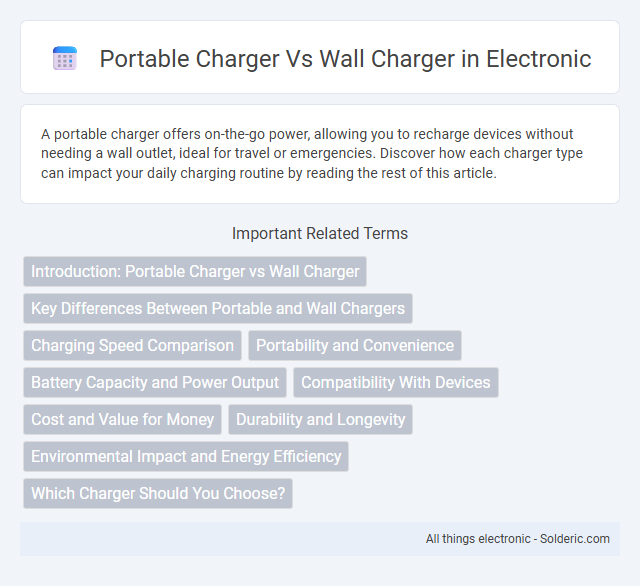A portable charger offers on-the-go power, allowing you to recharge devices without needing a wall outlet, ideal for travel or emergencies. Discover how each charger type can impact your daily charging routine by reading the rest of this article.
Comparison Table
| Feature | Portable Charger | Wall Charger |
|---|---|---|
| Power Source | Internal battery (power bank) | Direct AC power |
| Portability | Highly portable, ideal for travel | Stationary, requires outlet access |
| Charging Speed | Varies by capacity and output, typically slower | Generally faster with high wattage output |
| Power Capacity | Measured in mAh (5,000 - 30,000+ mAh) | Unlimited, dependent on outlet supply |
| Use Case | Charging devices on-the-go without outlet | Primary charging at home or office |
| Price | Moderate to high, depends on capacity | Low to moderate |
| Device Compatibility | Universal with USB, USB-C, Lightning outputs | Universal depending on charger type and plugs |
Introduction: Portable Charger vs Wall Charger
Portable chargers provide on-the-go power by storing energy in built-in batteries, offering flexibility and convenience without the need for an outlet. Wall chargers deliver consistent, faster charging through direct connection to electrical sockets but limit mobility due to dependency on fixed power sources. Comparing capacity, charging speed, and portability helps determine the best choice for specific device charging needs.
Key Differences Between Portable and Wall Chargers
Portable chargers offer the advantage of mobility, allowing users to charge devices on the go without needing a power outlet, while wall chargers require direct connection to an electrical socket for power. Portable chargers rely on built-in batteries with varying capacities, measured in milliamp-hours (mAh), which determine how many times a device can be recharged before the portable charger itself needs recharging. Wall chargers provide consistent and typically faster power delivery measured in watts (W) or amperes (A), making them ideal for stationary use and rapid charging scenarios.
Charging Speed Comparison
Portable chargers typically offer slower charging speeds compared to wall chargers due to battery capacity and output limitations. Wall chargers can deliver higher wattage, often supporting fast charging technologies like Quick Charge or USB Power Delivery, resulting in significantly reduced charging times. Ensure your device's compatibility to maximize charging speed whether you use a portable charger or a wall charger.
Portability and Convenience
Portable chargers offer unmatched portability and convenience by allowing users to charge devices on the go without needing access to a power outlet, making them ideal for travel, outdoor activities, or emergencies. Wall chargers require stationary use near electrical sockets but typically provide faster and more consistent power delivery, suitable for home or office use. Choosing between the two depends on lifestyle needs, balancing the convenience of mobility with the efficiency of fixed charging.
Battery Capacity and Power Output
Portable chargers typically offer varying battery capacities ranging from 5,000mAh to 30,000mAh, allowing you to charge devices multiple times on the go. Wall chargers provide consistent power output, often ranging between 18W to 100W, enabling faster charging speeds but require a fixed power source. Your choice depends on whether you prioritize mobility with sizable battery capacity or rapid charging with high power output.
Compatibility With Devices
Portable chargers offer broad compatibility across various devices, including smartphones, tablets, Bluetooth headphones, and smartwatches, thanks to multiple USB ports and adjustable voltage outputs. Wall chargers typically provide faster charging speeds but may have limited device compatibility due to fixed power ratings and connector types. Both options support standard USB-C and USB-A connections, ensuring seamless integration with most modern electronic devices.
Cost and Value for Money
Portable chargers offer excellent value for money by providing cost-effective, on-the-go power without the need for constant access to electrical outlets. Wall chargers tend to be less expensive upfront, but their limited portability reduces their overall convenience and utility in various situations. For your needs, investing in a portable charger can prove more economical over time due to its ability to keep devices charged anywhere, enhancing daily productivity.
Durability and Longevity
Portable chargers often feature rugged designs with impact-resistant materials, enhancing durability for on-the-go use, while wall chargers generally have fewer external protections, making them more susceptible to wear and tear from frequent plugging and unplugging. The longevity of portable chargers depends heavily on battery quality and charging cycles, typically lasting several years if properly maintained, whereas wall chargers tend to have longer lifespans due to fewer moving parts and minimal internal battery components. Your choice should consider the environment and usage frequency, as portable chargers excel in durability for travel, while wall chargers provide reliable longevity for stationary use.
Environmental Impact and Energy Efficiency
Portable chargers typically have a lower environmental impact than constantly using wall chargers since they allow you to charge devices without continuous electricity consumption from the grid. Wall chargers often draw power even when not actively charging, leading to standby energy waste, while portable chargers store energy efficiently for on-the-go use. Choosing a high-capacity portable charger with energy-efficient technology reduces your overall carbon footprint and supports sustainable energy practices.
Which Charger Should You Choose?
Choosing between a portable charger and a wall charger depends on your lifestyle and charging needs. Portable chargers offer the convenience of powering devices on the go, making them ideal for travel or outdoor activities, while wall chargers provide faster charging speeds when you have access to electrical outlets. Your decision should consider factors such as charging time, device compatibility, and the importance of mobility to ensure optimal performance for your daily use.
Portable charger vs wall charger Infographic

 solderic.com
solderic.com